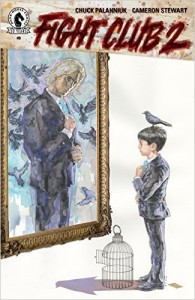 Fight Club 2 #9
Fight Club 2 #9
Dark Horse Comics
The penultimate issue of this Fight Club sequel is probably the most coherent so far, in that I actually mostly understand what the hell is going on. Sebastian, posing as Tyler, tricks his way into the castle where his son – Tyler’s actual host – is being kept. We learn the real reason that Sebastian’s shrink is helping him (he wants to be Tyler’s “vessel”), what Tyler’s real endgame is (fomenting worldwide conflicts and environmental catastrophe so that only a choice elect survive to rebuild the world after its destruction), and, true to Tyler’s styling himself as both God and Noah, he also reveals that he “[hasn’t] always taken human form.”
We also get some more metafictional weirdness, with Sebastian trying to call Chuck Palahniuk (or, as it’s spelled on Chloe’s phone’s display, “Polonic”) for advice or guidance or divine intervention or something. As one of the author’s writing group members says, “He’s Perseus petitioning the gods,” but I’m pretty sure that Perseus didn’t actually have Zeus’s cell number. I appreciate what I think Palahniuk is trying to do here – the apocalyptic theme that was only glanced in the original Fight Club is coming much closer to fruition; here in 2016, with accelerating climate change to the right, ISIS to the left, and who knows what else coming up behind us, the doomsday clock seems a lot closer to midnight than it did in 1996 (when the novel was published) or 1999 (when the movie came out). Watching those bank towers coming down at the end of Fight Club (which didn’t happen in the novel version, remember) feels a lot different today than it did seventeen years ago. Armageddon, Ragnarok, Helter Skelter, whatever you want to call it, erasing your credit score no longer seems like the salvation it once did.
The problem I’ve had with this series from the beginning is just how confusing it is. Again, maybe I’ll have to eat my words when I go back and reread it once the series is complete. But until we really know what Chuck’s place in Tyler’s cosmology is, the series can only maybe retroactively be worth it. And I say that as an enormous fan of Palahniuk’s work in general. There’s one issue left, but basically, wait for the trade before deciding to dive in here.
Where to Start: Fight Club 2 #1 Time investment: 8 issues
Recommended if you like this: Lullaby (tied for CP’s best novel, in my opinion)
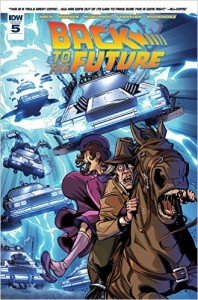 Back to the Future #5
Back to the Future #5
IDW Publishing
Issue 5 was supposed to be the last part of this series, but apparently the sales have been so good that they’ve expanded it into an ongoing title. I’ve got to admit that I was a little wary when that was first announced: I was on board for a 5-issue miniseries, but at what point does a Back to the Future comic that’s self-described as “Untold Tales and Alternate Timelines” (meaning no “new” stories but merely filling in gaps in the stories we already know) wear out its welcome? Fortunately, this is probably the best issue of the series so far, so I’m convinced, at least for the time being.
This issue is Clara’s Story. In Back to the Future 3 we got to know Clara a little bit, but she was mainly just Doc’s love interest; charming in her own way, but mostly just a device to enable Doc’s character development. Now we learn more about her, in her own words: we already knew that she developed her interest in science after her father bought her a telescope while she recovered from diptheria at age eleven, but we finally get to see her encounter with Doc and Marty from her point of view – as well as what exactly Doc told her about his history with Marty and time travel after he sent Marty back to the future, including a very creepy encounter in the alternate 1985. Here, Doc is on the brink of reinventing time travel with what I’m convinced is the coolest locomotive in all of film, Doc’s Time Train, and basically anything that lets us see more of that thing is okay with me.
Where to Start: Back to the Future #1 Time investment: 4 issues
Recommended if you like this: Ghostbusters: Mass Hysteria
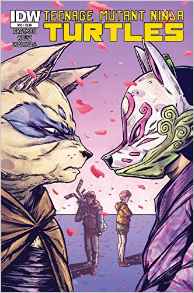 Teenage Mutant Ninja Turtles #55
Teenage Mutant Ninja Turtles #55
IDW Publishing
Tying together a lot of the disparate plot threads going on throughout the title, this issue is self-contained but considering how much is going on all at once, quite a lot actually happens. It’s about separating and coming back together: Michelangelo, who split from his family after Splinter took over as leader of the Foot Clan, only to be disappointed and borderline-betrayed by his friends the Mutanimals as well, returns to the Turtles’ old lair, the last place he knew as home, where he’s eventually met by his brothers (and a piping hot pizza!) on their way to meet the Fugitoid.
Angel and Alopex seem to be making a good team as they set a trap for the Street Phantoms, only for Alopex to be enchanted (literally) by the captive Kitsune. Alopex is an interesting character; although I really have yet to be super impressed by any of the original characters from the IDW series, Kitsune is obviously a character for whom the writers have an affection. I know that Sophie Campbell (credited as Ross Campbell when she illustrated the Alopex microseries in 2013) was a noted proponent of the character, but I’ve always kind of wondered why they decided to create a whole new character when another very similar character fromTMNT’s back catalogue already existed – Ninjara, from the series published by Archie Comics, another fox-woman who started out evil and turned good, and who also was portrayed as a love interest for Raphael. Were there rights issues or something?
At any rate, she’s the one original character in this series to whom the most attention has been paid and it makes perfect sense that she could fall under the control of Kitsune; everyone knew that Kitsune was only biding her time, but nobody expected – or at least I didn’t expect – that she’d see the fox as her ticket out. It took a while for Alopex to earn the Turtles’ trust, so what’s going to happen when – under a witch’s spell or not – she betrays that trust?
Also April and Casey break up.
Where to Start: Teenage Mutant Ninja Turtles #1 Time investment: 54 issues
Recommended if you like this: Kevin Eastman Notebook Series 2014 Annual
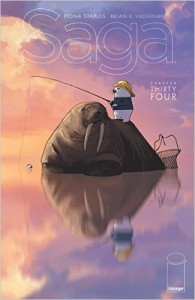 Saga #34
Saga #34
Image Comics
“I know diversity is an overused word these days,” Hazel tells us in this issue’s narration, “but without it, what would we be?” Saga is many things, but nobody can accuse it of being insufficiently diverse. Chapter 34 sees the continuation of the series’s theme of misery’s acquainting one with all sorts of strange bedfellows, pounding home the notion that, again in Hazel’s words, “we’re all aliens to someone,” but making common cause with people we’d normally never voluntarily hang around with is a great way to gain some new perspectives. Intersectionality can be a weird and problematic paradigm (much like, uh, pretty much everything else), especially if you want your ethics to be internally consistent – on the one hand it risks turning into a Monty Pythonesque Oppression Olympics, but then again forget all about it and you might get homosexual mermen or transgender prisoners of war insisting that a guy with horns falling in love with a woman with wings is the height of sickness and perversion and they ought to be locked up or shot.
https://www.youtube.com/watch?v=wgsdSOhW1mU
There’s a whole article in Saga’s intersectionality but this isn’t it – this is just a review, after all – and that potentially heavy stuff is dwarfed here by Fiona Staples’ relentlessly fantastic art, especially one adorable panel where Alana throws up her arms in delight (as in stretching toward the sky, not, like, vomitting guns) at her reunion with Ghüs’s pet giant walrus thing, Friendo. Friendo! We all love Friendo.
Where to Start: Saga Volume 1 Time investment: 33 issues
Recommended if you like this: Paper Girls Volume 1
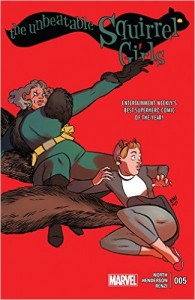 The Unbeatable Squirrel Girl #5
The Unbeatable Squirrel Girl #5
Marvel Comics
The resolution of the “Squirrel Girl is trapped in the 1960s and Doctor Doom is there too!” storyline, and there’s not a lot to say about this issue that I didn’t already say about the last issue – except that at the beginning of this issue we get two Squirrel Girls, the regular one from the future, and then the Old Lady Squirrel Girl from another future where Squirrel Girl One didn’t beat Doctor Doom in the fight they are fighting right now, but went on to live for a few more decades and then travelled back in time to give the past version of her a little extra help in winning the fight this time around.
Now, I don’t want to give anything away, but I am totally about to give it away give it away give it away now, so look away if you don’t want the end of this comic spoiled for you: the way that Doreen manages to defeat Doom in this issue is just perfect. It’s both respectful of Doom as a character that really shouldn’t be able to be dispensed with in a silly way (unlike, say, Kraven or even Galactus, both of whom SG has bested in this series using her brains and not so much her brawn, even though she’s got plenty of the latter when she needs it), but also respects Squirrel Girl enough not to have her and her allies simply physically kick the crap out Doom without any other sort of thematically appropriate or narratively satisfying conclusion. No, Squirrel Girl gets to eat her peanut-flavoured hard candy and have it too, complete with a brilliant callback to SG’s first appearance, where she defeated Doom by enveloping him with an overwhelming scurry of squirrels. Did you know that a group of squirrels is called a scurry? Neither did I, but now we both do! This time around, she defeats him by enveloping him in a crowd of humans (did you know that a group of humans is called a crowd?) – specifically, a crowd of versions of herself (like twelve or thirteen of her at least) that she collects by getting Nancy to keep sending her back in time by yelling in C++ thus also undermining Doom’s ability to foil SG’s plans by, you know, listening when she tells her teammates what she wants them to do (Doom doesn’t know C++, see?).
I am pretty sure that Ryan North came up with this by contemplating, “How would Squirrel Girl defeat Doctor Doom if she couldn’t just summon hundreds of squirrels to get all up in his fries?” and realizing the answer was “summoning a hundred girls to get all up in his fries,” since it is well-established that Squirrel Girl has all the powers of both squirrel and girl. This is pretty much how all problems should be solved.
If nothing else, you should buy this comic for the one panel on page six where Regular Squirrel Girl and Old Lady Squirrel Girl high-five after a particularly sick pun. The looks on her faces is priceless. Artist Erica Henderson? You nailed it.
Where to Start: The Unbeatable Squirrel Girl #1 Time investment: 4 issues
Recommended if you like this: Bill & Ted’s Most Triumphant Return
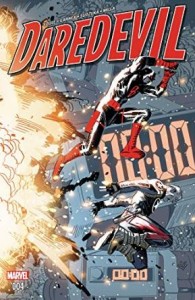 Daredevil #4
Daredevil #4
Marvel Comics
Taking on the Chinatown cult leader Tenfingers has Daredevil stymied, so he calls for assistance from the most heroic hero of all: Steve Rogers, former Captain America, current Really Old Guy, future Captain America Again. I may have used that exact line in a previous Reading List. I’m not sure, but it sounds familiar. I’m writing this at two in the morning, so cut me some slack. Anyway, the one thing in this issue that signals just how good writer Charles Soule is is that he doesn’t forget that among all his strengths, Daredevil still has weaknesses. 360-degree radar sense is great and all, but it doesn’t tell him how much time is left on the digital display of a bomb that’s ticking down, or which wire is the green one and which is the yellow when Captain America is describing how to defuse it. And how it just makes Matt feel worse that he can’t tell Steve who he really is – especially since Cap, and the rest of the world, not so long ago knew everything about Daredevil’s true identity. We still don’t know quite what he had to do to get that information retconned – Soule is dripping that on us slowly – but we do know that he feels guilty about it, guilty and cowardly. For the Man Without Fear, that’s got to be tough.
Where to Start: Daredevil #1 Time commitment: 3 issues
Recommended if you like this: Captain America: To Serve and Protect
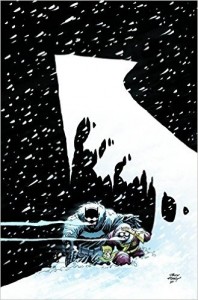 The Dark Knight III: The Master Race #3
The Dark Knight III: The Master Race #3
DC Comics
Frank Miller’s Holy Terror was accused of being…let’s say unsubtle…and in that, at least, the critics were not completely wrong. The Dark Knight III is treading on not dissimilar ground. The “Nazi Supermen” trope is in effect here, of course, clearly evoked in the series subtitle, but the Kryptonian leader Quar also styles himself as a kind of religious leader, not just a superman but a god, a god who sends his children to Earth to die for a cause – except that cause is Earth’s own subjugation, and the Kryptonians’ deaths come by turning themselves into nuclear bombs to destroy the cities of this world.
The situation is so out of hand that Batman treks to the Fortress of Solitude where Superman has frozen himself in ice. The extent to which this is Brian Azzarello’s book (as opposed to Frank Miller’s) is not entirely clear, but what’s certain is that this series is and continues to be quality.
Now please excuse me, but I am so very very sleepy.
Where to Start: The Dark Knight II: The Master Race #1 Time commitment: 2 issues
Recommended if you like this: Batman Noir
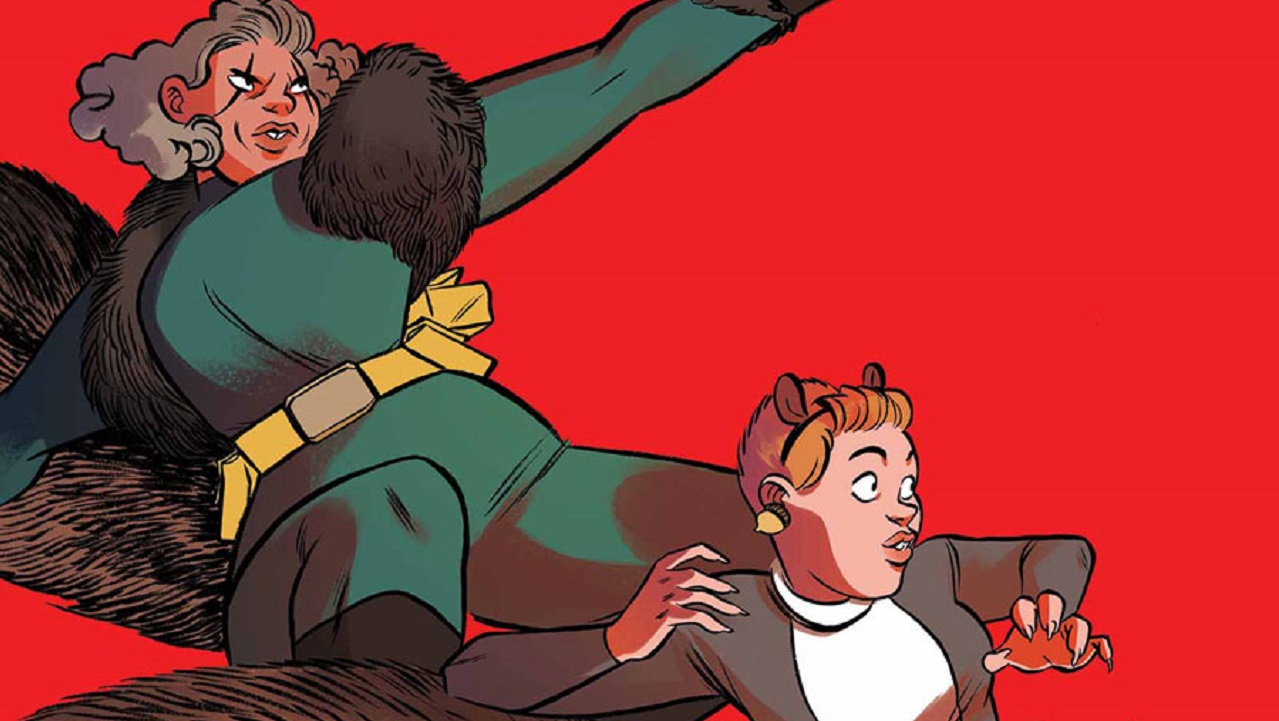
Add a Comment